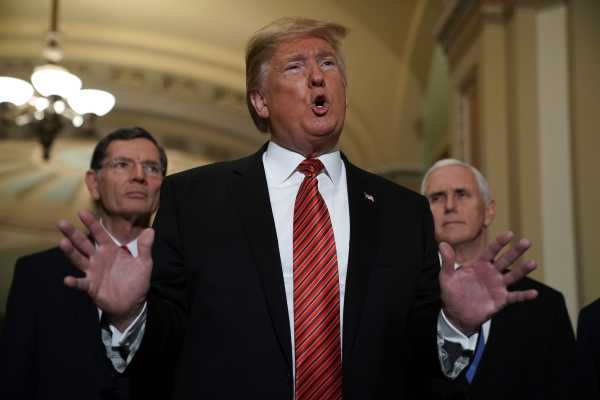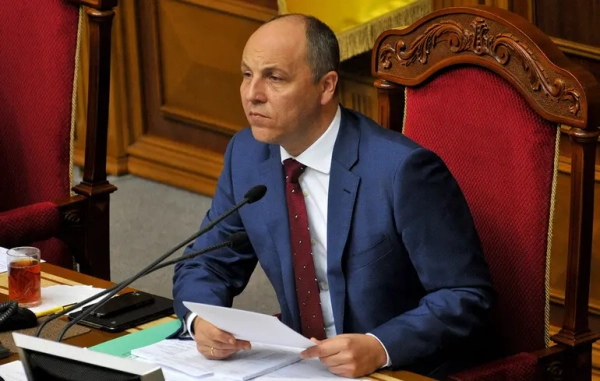
According to reporting from the New York Times’s Peter Baker, President Donald Trump believed in advance of his Tuesday night Oval Office address that speaking to the public about his desire for a border wall was pointless.
And, according to Baker, he did not want to make the publicity stunt trip to the Texas border zone that is scheduled for Thursday.
“It’s not going to change a damn thing, but I’m still doing it,” Trump reportedly said before gesturing at some of his communications aides and saying he’s going to do it despite his doubts because “these people behind you say it’s worth it.”
Trump, however, was right. Time and again, even presidents who are universally regarded as eloquent public speakers and effective public communicators — think Ronald Reagan or Barack Obama — have tried and failed to bring public opinion around to their point of view by talking about it. Trump is not a charming, eloquent figure in their mold. The presidential “bully pulpit” is one of the office’s real powers, but it simply doesn’t work the way proponents of this kind of table-pounding strategy want it to.
And that goes double or triple for a crude and unpopular president like Trump. The place for him to make progress toward his goals on border security is the obscure back rooms of Congress where deals can be cut and priorities swapped. Talking about his agenda in high-profile ways — and dramatizing his commitment to it by shutting down the government — is completely counterproductive, serving only to fire up millions of banal Democrats who’ve never in their lives held an opinion about what kind of border security measures are appropriate in rural West Texas in order to oppose Trump at every turn.
Presidential speeches don’t persuade the public
George C. Edwards, a Texas A&M political scientist, undertook a comprehensive study of presidential speechmaking and public opinion for his 2006 book On Deaf Ears: The Limits of the Bully Pulpit.
What he finds is, basically, it doesn’t work: High-profile presidential addresses simply fail to influence public opinion.
At times, we end up mythologizing presidential communications in ways that are at odds with the public record. Edwards notes, for example, that FDR gave “only two or three fireside chats a year, and rarely did he focus them on legislation under consideration in Congress.” Of that group, the most clearly legislative-focused one was his 1937 advocacy for his court-packing plan — a plan that failed. And while some of the chats advocating for greater US involvement in World War II came to look prescient after Pearl Harbor, that doesn’t mean they were actually persuasive at the time.
A Drew DeSilver article for the Pew Research Center from 2013 reminds us that a string of Oval Office addressed by Ronald Reagan failed to move the needle on voters’ view of providing aid to the Contras in Nicaragua, George W. Bush’s congressional address on behalf of comprehensive immigration reform left opinion flat, and George H.W. Bush’s speech defending his bipartisan congressional budget deal did nothing to change views.
Indeed, the general tendency is for public opinion to move in the opposite direction from the president’s preferences — a regulatory model that’s known as the thermostatic model of public opinion.
Reagan was an influential president because public opinion became very conservative in the late 1970s, leading to election results in 1980 that allowed him to govern effectively while the strong economic rebound in 1983-’84 helped him secure a landslide reelection bid. But according to Edwards, “surveys of public opinion have found that support for regulatory programs and spending on health care, welfare, urban problems, education, environmental protection and aid to minorities increased rather than decreased during Reagan’s tenure,” while support for higher military spending fell.
The longer he stayed in office, in other words, the less the public worried that liberals were out of control and the more they worried that traditional liberal priorities were being neglected.
Similarly, public opinion on immigration keeps becoming more favorable the longer Trump persists in office. The good news, for him, is that as president, he has formidable tools at his disposal to shift policy in ways he thinks are important. But to make that happen, he needs to shut up.
Presidential involvement is counterproductive in Congress
Bipartisan dealmaking gets done all the time in Congress, even in today’s polarized atmosphere. But the key to getting a bipartisan deal done is typically for the president to avoid putting his hands all over it.
The landmark Every Student Succeeds Act that passed Congress in late 2015, for example, obviously wouldn’t have passed unless it incorporated a lot of education policy ideas that the Obama administration was on board with. But it was put together quietly, by negotiators from both parties, without a lot of presidential tweets and speechmaking.
The downside of this, from Obama’s point of view, was that signing it doesn’t count in the public imagination as an Obama achievement or a major win for his administration. But precisely because it didn’t count as a big “win” for Obama, congressional Republicans could sign on to it.
As the University of Maryland’s Frances Lee explains in her book Beyond Ideology: Politics, Principles, and Partisanship in the United States Senate, members of Congress have two different kinds of preferences. Preferences on issues are amenable to compromise because you can either accept half a loaf or else swap something you care about for something you don’t care about. But the preference to win is inherently zero-sum. For Republicans to get Democrats to agree to something on substance, they can’t also demand that Democrats hand them a political win.
In this view, there is no more catastrophic intervention possible than Sen. Lindsey Graham (R-SC) chiming in to remark that “if Trump caves, it’s the end of his presidency.”
This may be a good way to motivate Republicans to hang with Trump even if they don’t really agree with his strategy. But House Democrats are going to look at that kind of effort and redouble their resolve to resist Trump. If you actually want the $5.7 billion appropriation to build steel slats, you need to lower the stakes, not raise them.
Trump has created a mess with no way out
Republican senators have taken to pointing out on social media that various prominent Democrats, including Hillary Clinton and Barack Obama, have in the past voted for broadly similar fence-building measures.
But that merely goes to show how poorly the GOP has played its hand here. If Trump had simply stayed quiet and let congressional allies ask for a $5.7 billion fence appropriation, Democrats would have shot back that $5.7 billion is an awful lot of money and asked what they’re getting in exchange. Negotiations over appropriations are never easy, but both parties usually manage to come out of them with their top priorities intact.
The awkward problem for Trump would be that this steel bollard structure doesn’t seem like the 30-foot concrete wall he described during the campaign. But if he’d stayed quiet and reluctantly signaled willingness to sign a fence-rather-than-wall bill, he could’ve gotten it done.
Instead, while whipping his base into a wall fervor, he also created anti-wall enthusiasm on the Democratic side. Then he redefined “the wall,” and suddenly fencing he’d previously deemed inadequate and Democrats deemed unobjectionable became subject to the exact same polarization dynamics.
Then in the Oval Office speech, he made things worse again: He explicitly linked the slat wall not to some narrow technical Border Patrol objective about funneling people away from some specific patch of land, but to the entire Trumpian worldview, in which immigrants are coming over the border to kill you.
Taken literally, of course, it doesn’t have to be this way.
First-term Texas Republican Rep. Dan Crenshaw, for example, gestured toward a deflationary account of what’s at stake that could conceivably have worked in Congress had Republicans pursued it.
The problem is that Crenshaw blames “Democrats” who “are pretending” that this is a high-stakes political battle about the big beautiful wall that Trump made the centerpiece of his 2016 campaign message. However, it’s clearly Trump who’s to blame.
You don’t shut down the government over a dispute between a $1.3 billion and a $5.7 billion appropriation — you pass a continuing resolution while you keep talking it over. But Trump has drastically elevated the stakes, over and over again, by shutting down the government, equating the proposal with his wall, and concocting a fake border crisis to which somehow a multi-year construction project is an urgently needed solution.
It’s incredibly stupid, and Republicans like Crenshaw who know better need to talk to Trump about it, not their political enemies. Reopen the government, start tweeting about something else, let congressional appropriators do their boring horse-trading, and they will find some money for some steel slats.
But to get that, Trump needs to be willing to humble himself on the fence-versus-wall semantics and step out of the spotlight. And that doesn’t sound like Trump at all.
Sourse: vox.com






